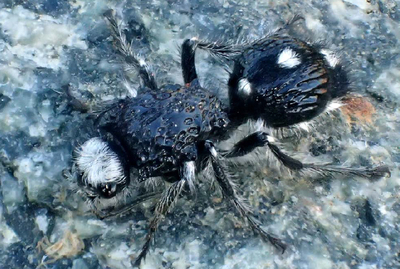How do you tell an ant from a wasp?
According to Bill Bowden an ant is a Canadian’s aunt, and a wasp is a white Anglo Saxon pig. However Jane Slater wins a free coffee at the Crazy Cocky Café for the correct answer. A wasp's antenna is generally straight, but that of an ant has a distinct kink.
A while ago I asked Alan Kerrigan to photograph a bulldog (sergeant) ant and mentioned seeing a small white spotted ant. Alan discovered a flower wasp that fitted the description. The wingless female lives in flowers and attracts the winged male who carries her away to mate. And to confuse things further it is called the greater black velvet ant. Don’t be fooled by the wonderful punk hair, velvet ants are also called ‘cow killers’. So take care next time you sniff a rose!
Alan also photographed the Sergeant/Bulldog ant without getting bitten. The biggest and among the most primitive of our ants, they also deserve respect as they have both big jaws and a sting.
To quote the Australian Museum: Bull ants are large, alert ants that can grow up to 40 mm They have characteristic large eyes and long, slender mandibles and a potent venom-loaded sting. They have superior vision, able to track and even follow intruders from a distance of 1 metre. Many species of bull ants have bright red or orange colours on the head or abdomen.
Bull ant nests are usually underground and often have hidden or small entrances. The nests can extend several metres below the ground. They attack intruders of any size that come too close to their nest. Bull ants also have well-developed vision and will follow or even chase an intruder a good distance from the nest. Usually the sight of large aggressive ants streaming out of the nest is enough to prompt a hasty retreat. If not, the ants deliver painful stings by gripping the intruder with their mandibles (jaws), curling their abdomen to reveal the sting and injecting the victim with venom. Often multiple stings are delivered.
Their nests are easy to recognise as they have large openings and relatively few residents, but don’t put a stick in their nest.
I know of a naughty young boy who decided to wage war on bull ants by putting fireworks in their nest, but made the mistake of returning to inspect the results. Very sad.
However they hunt alone and will just ignore you if you don’t bother them. I haven’t been attacked in my adult life.

